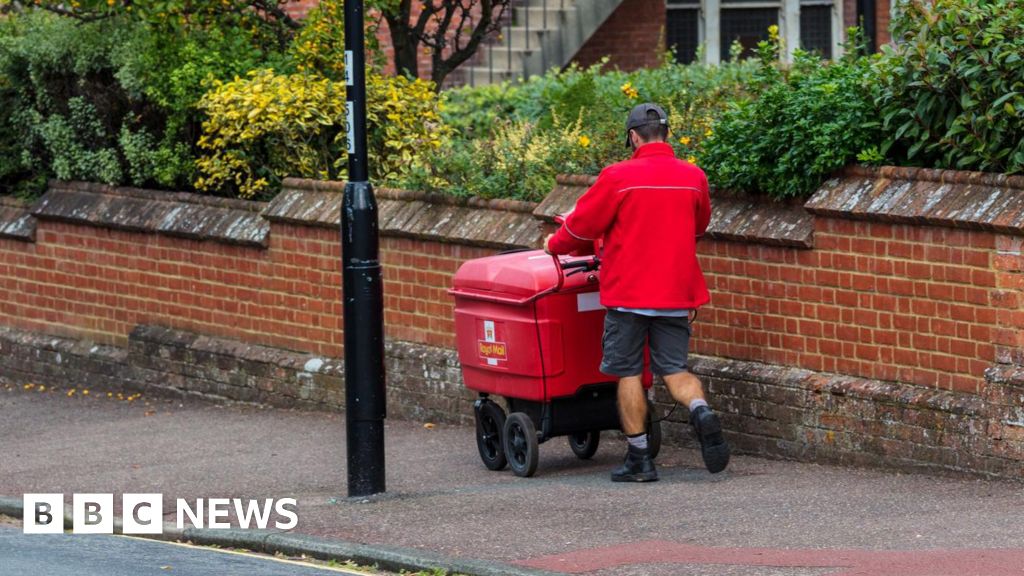Business
Royal Mail fined £21m by Ofcom for missing delivery targets

Emer MoreauBusiness reporter
 Getty Images
Getty ImagesRoyal Mail has been fined £21m after almost a quarter of first-class post arrived late, Ofcom has announced.
It is the third-largest fine the communications watchdog has ever issued and follows its investigation after Royal Mail missed its targets for both first and second-class post in 2024/25.
Ian Strawhorne, director of enforcement at Ofcom, said: “Millions of important letters are arriving late, and people aren’t getting what they pay for when they buy a stamp.”
Royal Mail said it will “continue to work hard to deliver further sustained improvements to our quality of service”.
It delivered 77% of First Class mail and 92.5% of Second Class mail on time in the 2024/25 financial year, which was short of its 93% and 98.5% targets.
This is the third time it has been fined over delivery delays in recent years, with penalities of £5.6m in November 2023 and £10.5m in December 2024.
Ofcom said the fine would have been £30m, but it had reduced it by 30% to reflect Royal Mail’s admission of its failings.
The regulator warned fines were “likely to continue” unless the company urgently delivers “a credible improvement plan”.
‘Empty promises’
Ofcom said Royal Mail published an improvement plan for last year, aimed at delivering 85% of first-class post on time and 97% of second-class post, but “this has not materialised”.
Mr Strawhorne said: “Royal Mail must rebuild consumers’ confidence as a matter of urgency. And that means making actual significant improvements, not more empty promises.”
Ofcom’s investigation found the company “breached its obligations by failing to provide an acceptable level of service without justification”.
It said the actions taken by Royal Mail to try and reach its targets were “insufficient and ineffective”.
The fine, Ofcom said, reflected the “harm suffered by customers” as a result of Royal Mail’s poor service.
Citizens Advice said the postal service’s track record was “woeful” but that the fines may not push the company to do better.
“When these failures are just an ordinary part of doing business, Ofcom’s fine risks becoming another operating cost, doing little to encourage the company to improve its service,” Tom MacInnes, director of policy at Citizens Advice, said.
“Missed post has real life consequences, with people left waiting for urgent medical appointment letters, legal documents and benefit decisions.”
Second-class scrapped on Saturdays
Under the universal service obligation (USO), Royal Mail is required by law to deliver letters six days a week and parcels five days a week to every address in the UK.
Since July, some areas only receive second-class letters every other weekday and not on Saturday, a change proposed by Ofcom earlier this year.
Responding to Ofcom, a Royal Mail spokesperson said: “We acknowledge the decision made by Ofcom today and we will continue to work hard to deliver further sustained improvements to our quality of service.”
The spokesperson said that the reduction of second-class deliveries in some areas enabled the company to “drive a step change in quality of service”.
Royal Mail has also made changes in recruitment and training and has provided more support in delivery offices, the spokesperson added.
The fine will be paid to the Treasury.
Royal Mail was bought by Czech billionaire Daniel Kretinsky for more than £5bn last year. It posted a profit in September, following three years of losses.
Business
OGRA Announces LPG Price Increase for December – SUCH TV

The Oil and Gas Regulatory Authority (OGRA) has approved a fresh increase in the price of liquefied petroleum gas (LPG), raising the cost for both domestic consumers and commercial users.
According to the notification issued, the LPG price has been increased by Rs7.39 per kilogram, setting the new rate at Rs209 per kg for December. As a result, the price of a domestic LPG cylinder has risen by Rs87.21, bringing the new price to Rs2,466.10.
In November, the price of LPG stood at Rs201 per kg, while the domestic cylinder was priced at Rs2,378.89.
The latest price hike is expected to put additional pressure on households already grappling with rising living costs nationwide.
Business
Private sector data: Over 2 lakh private companies closed in 5 years; govt flags monitoring for suspicious cases – The Times of India

NEW DELHI: The government on Monday said that over the past five years, more than two lakh private companies have been closed in India.According to data provided by Minister of State for Corporate Affairs Harsh Malhotra in a written reply to the Lok Sabha, a total of 2,04,268 private companies were shut down between 2020-21 and 2024-25 due to amalgamation, conversion, dissolution or being struck off from official records under the Companies Act, 2013.Regarding the rehabilitation of employees from these closed companies, the minister said there is currently no proposal before the government, as reported by PTI. In the same period, 1,85,350 companies were officially removed from government records, including 8,648 entities struck off till July 16 this fiscal year. Companies can be removed from records if they are inactive for long periods or voluntarily after fulfilling regulatory requirements.On queries about shell companies and their potential use in money laundering, Malhotra highlighted that the term “shell company” is not defined under the Companies Act, 2013. However, he added that whenever suspicious instances are reported, they are shared with other government agencies such as the Enforcement Directorate and the Income Tax Department for monitoring.A major push to remove inactive companies took place in 2022-23, when 82,125 companies were struck off during a strike-off drive by the corporate affairs ministry.The minister also highlighted the government’s broader policy to simplify and rationalize the tax system. “It is the stated policy of the government to gradually phase out exemptions and deductions while rationalising tax rates to create a simple, transparent, and equitable tax regime,” he said. He added that several reforms have been undertaken to promote investment and ease of doing business, including substantial reductions in corporate tax rates for existing and new domestic companies.
Business
Pakistan’s Textile Exports Reach Historic High in FY2025-26 – SUCH TV

Pakistan’s textile exports surged to $6.4 billion during the first four months of the 2025-26 fiscal year, marking the highest trade volume for the sector in this period.
According to the Pakistan Bureau of Statistics (PBS), value-added textile sectors were key contributors to the growth.
Knitwear exports reached $1.9 billion, while ready-made garments contributed $1.4 billion.
Significant increases were observed across several commodities: cotton yarn exports rose 7.74% to $238.9 million, and raw cotton exports jumped 100%, reaching $2.6 million from zero exports the previous year.
Other notable gains included tents, canvas, and tarpaulins, up 32.34% to $53.48 million, while ready-made garments increased 5.11% to $1.43 billion.
Exports of made-up textile articles, excluding towels and bedwear, rose 4.17%, totaling $274.75 million.
The report also mentioned that the growth in textile exports is a result of improved global demand and stability in the value of the Pakistani rupee.
-

 Sports1 week ago
Sports1 week agoWATCH: Ronaldo scores spectacular bicycle kick
-

 Entertainment1 week ago
Entertainment1 week agoWelcome to Derry’ episode 5 delivers shocking twist
-

 Politics1 week ago
Politics1 week agoWashington and Kyiv Stress Any Peace Deal Must Fully Respect Ukraine’s Sovereignty
-

 Business1 week ago
Business1 week agoKey economic data and trends that will shape Rachel Reeves’ Budget
-

 Tech6 days ago
Tech6 days agoWake Up—the Best Black Friday Mattress Sales Are Here
-

 Politics1 week ago
Politics1 week ago53,000 Sikhs vote in Ottawa Khalistan Referendum amid Carney-Modi trade talks scrutiny
-

 Fashion1 week ago
Fashion1 week agoCanada’s Lululemon unveils team Canada kit for Milano Cortina 2026
-

 Tech1 day ago
Tech1 day agoGet Your Steps In From Your Home Office With This Walking Pad—On Sale This Week






